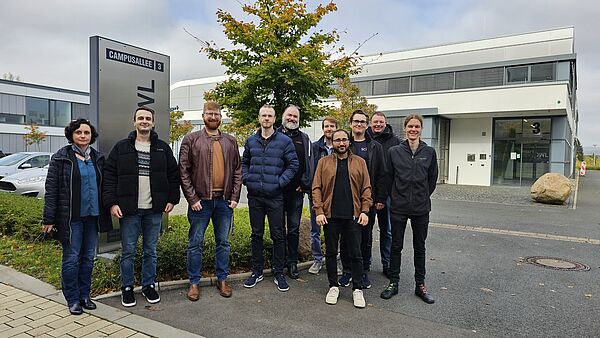From 22 to 24 October, the DeSiRe-NG research project led by Prof. Henning Trsek reached its third milestone. The event was hosted by the Technische Hochschule Ostwestfalen-Lippe (TH OWL).
The project consortium, consisting of the Institute Industrial IT (inIT) of TH OWL, TU Ilmenau, NUROMEDIA GmbH, InnoZent OWL e.V. and Lufthansa Industry Solutions AS GmbH, met at the SmartFactoryOWL in Lemgo. The aim of the meeting was to present further results of the project to the DLR project management in a milestone meeting. The third milestone of the project has been reached.
First implementation in SmartFactoryOWL
The inIT team consisting of Maxim Friesen, Niels Hendrik Fliedner, Natalia Moriz, Erdem Sengün and Prof Dr Henning Trsek welcomed the project partners to the SmartFactoryOWL. During the meeting, a mobile measurement system for relevant parameters of a 5G campus network was successfully implemented. The interfaces of the backend systems developed separately by the partners were connected for the first time, integrated and then evaluated in a test run.
The test run replicated the use case of virtual turbine maintenance with high-resolution image transmission. For this purpose, a video call was initiated via the 5G campus network connection. In the next step, a software-defined radio (SDR)-based interferer was activated, which, as expected, initially caused the video signal transmission quality to drop and ultimately caused the video call to be cancelled completely.
The measurement framework mounted on a remote-controlled ground vehicle monitored the power quality. During the induced interference, the ground vehicle was moved close to the suspected interference source and a measurement was then initiated by a central orchestrator. During this measurement, the vehicle recorded the connection quality of the 5G campus network depending on its position in order to narrow down the source of interference. The recorded data was collated in real time in a central database so that measures to improve resilience can be taken in the next step.
In the virtual turbine maintenance use case, turbine parts are inspected with a mobile camera at project partner Lufthansa Industry Solutions. The image transmission requires high network availability with good quality, which can only be guaranteed by a resilient 5G campus network. To achieve this, any interferers must be identified, localised and rendered harmless.
Prof Dr Henning Trsek gave a positive summary of the project: Together with our project partners, we were able to successfully integrate the measurement system and the associated backend. As a result, we will be able to carry out targeted measurements in order to effectively localise disruptive influences. This type of localisation is an important first step towards increasing the resilience of 5G campus networks.


